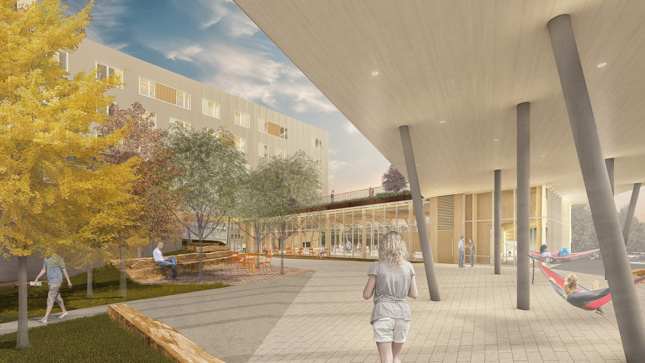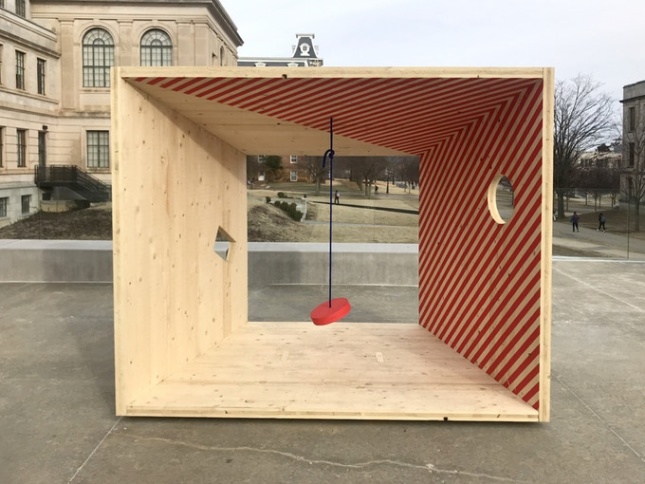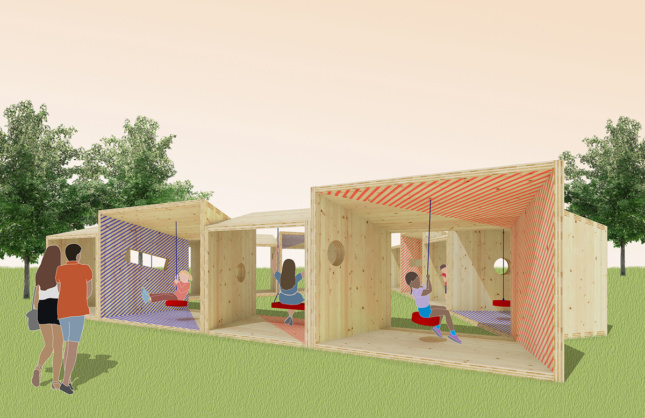The average swingset, built in backyards and playgrounds across the country, features loads of metal and plastic. Somewhere Studio, a young firm based in Arkansas, is unintentionally turning that unsustainable construction on its head with Salvage Swings, a series of swing modules made from reclaimed timber. Coming to Roosevelt Island this summer, the project is the official 2019 City of Dreams Pavilion winner, selected through a competition hosted annually by the New York Chapter of the American Institute of Architects, the Structural Engineers Association of New York, and FIGMENT, a local arts organization.
Salvage Swings was born out of the University of Arkansas’s Fay Jones School of Architecture and its Fabrication Laboratories. Jessica Colangelo and Charles Sharpless, founders of Somewhere Studio, teach at the Fayetteville campus and conceived of the project last year as a way to reuse the wood leftover from the construction of the school’s new student housing project, Stadium Drive Residence Halls. The 200,000-square-foot mass timber building, designed by local firm Modus Studio, as well as Mackey Mitchell Architects, Leers Weinzapfel Associates, and OLIN, using cross-laminated timber and glulam-panels from Binderholz, an Austrian manufacturer that ships its products on sacrificial palettes also made of CLT. Somewhere Studio is taking these palettes and using them for the pop-pup playspace in New York.

According to Sharpless, the palettes are perfect products to experiment with because they aren’t graded for commercial use. “Even though it’s a raw material that’s basically used for storage, it looks and behaves like processed cross-laminated timber,” he said. “When we began the project, it occurred to us that we had this big pile of wood staring at us that would otherwise be thrown away, so we decided we wanted to show off its quality and strength.”
Designed to stand as a temporary public piece of interactive art, Salvage Swings will feature 12 individual swing modules that can be set up together to form a triangular communal space. Each module will be constructed from the palettes, which will be cut, cleaned, and sealed at UArk, and then painted with different patterns and colors to add personality. Sharpless noted the idea to create a swingset wasn’t top of mind at the start of the design process, but the use of salvaged timber heavily drove the form of the installation.

“The shape of the boxes is intended to provide some structural rigidity,” Sharpless said. “CLT is light, flexible, and you can work with it quickly. We angled each box so that when you’re looking at one from a single direction, it starts to flatten out. Then from another direction, it starts to heighten your perspective and create a sense of layers.”
These changing perspectives also bring a sense of playfulness to the pavilion—a core goal that Somewhere Studio tries to achieve in its work. Repetition is another design move the firm often features. In the triangular shape of Salvage Swings, the repeating boxes provide unique frames for visitors to view Roosevelt Island and the surrounding city.

While Salvage Swings is in-part an experiment in the effectiveness of CLT as an exterior construction material, the project is also a way to encourage fun. “We like the idea of engaging people who might not be attracted to an architectural or art installation or know immediately what ours is made of,” said Sharpless. “So it’s exciting to showcase this really beautiful product and educate the public about its strength. At the end of the day, though, we want people to have fun and, in particular, for children to gain a sense of play from the pavilion. They’re a great audience and I don’t think we’re designing enough for them.”
Salvage Swings is currently accepting donations to build the project through a Kickstarter campaign, which ends on March 23. As of today, the project is fully funded. Now that the total money has been raised, Colangelo and Sharpless will construct the pavilion for the 2019 summer season on Roosevelt Island, collaborating with Taylor and Miller Architecture and Design on lighting for the modules, as well as Guy Nordenson and Associates on their structural engineering. Come fall, Salvage Swings will likely be broken down into parts, according to Sharpless, where a section will stay in New York and another will be set up in Arkansas.











